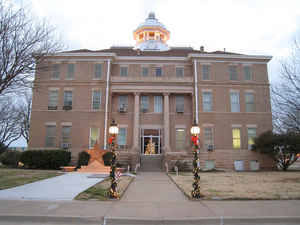Texas Counties
Texas is divided into two hundred and fifty-four counties, more than any other state. Texas was originally divided into municipalities, a unit of local government under Spanish and Mexican rule. When the Republic of Texas gained its independence in 1836, there were 23 municipalities, which became the original Texas counties. Many of these would later be divided into new counties. The most recent county to be created was Kenedy County in 1921. The most recent county to be organized was Loving County in 1931Hardeman County, Texas
Hardeman County Education, Geography, and History

Hardeman County is a county located in the state of Texas. Based on the 2010 census, its population was 4,139. The county seat and largest city is Quanah. The county was created in 1858 and later organized in 1884. It is named for two brothers, Bailey Hardeman and Thomas Jones Hardeman, early Texas politicians and legislators.
Etymology - Origin of Hardeman County Name
Bailey Hardeman and Thomas Jones Hardeman, two early Texas politicians and legislators
Demographics:
County QuickFacts: CensusBureau Quick Facts
Hardeman County History
Hardeman County is a county located in the US state of Texas. Hardeman County is named for Bailey Hardeman and Thomas Jones Hardeman, two early Texas politicians and legislators. The seat of the county is Quanah, where most of the county population resides.
Handbook of Texas Online
Lipan Apaches dominated the region in the sixteenth and seventeenth centuries. Later the semisedentary Wichita
Indians settled along the Red River. After 1700 the Comanches and Kiowas also migrated from the north to hunt
buffalo and other game. The county was formed in 1858 from Fannin County and named for early Matagorda legislators
Bailey and Thomas Jones Hardeman.q Because of its isolation and the continued
threat of Indian attack, however, the area remained unsettled during the Civil War and Reconstruction.q
After the Civil War a few buffalo hunters and ranchers moved to the region, but it was still only very sparsely
settled when the county was organized in 1884. In the 1870s and 1880s rustling was among the principal industries,
as thieves headed for Indian Territory crossed Hardeman County to reach the Red River. From 1881 to 1884 Wilbarger
County administered Hardeman County's legal affairs, though its handful of settlers had few administrative needs.
The 1880 population of Hardeman and Foard counties together totaled only fifty, but population increases in Hardeman
County and adjacent regions justified organization in 1884 and a change in county lines some years later. Margaret,
first called Argurita, was the original county seat. In 1885 the Fort Worth and Denver Railway made a survey through
the area, and the site of Quanah was laid out. Since Margaret was across the Pease River from other settlements and
from the railroad, an election held in 1890 made Quanah the county seat. As it was decided that a voter could
establish residence by having his laundry done in a town for six weeks, all the railroad crews are said to have
become citizens in time to vote for Quanah. In 1891 Foard County was formed from Hardeman, Cottle, King, and Knox
counties, a division that left Margaret in Foard County. More at
Christopher Long, "HARDEMAN COUNTY," Handbook of Texas Online (http://www.tshaonline.org/handbook/online/articles/hch05),
accessed January 23, 2016. Uploaded on June 15, 2010. Published by the Texas State Historical Association.
Geography: Land and Water
As reported by the Census Bureau, the county has a total area of 697 square miles (1,805 km2), of which, 695
square miles (1,801 km2) of it is land and 2 square miles (4 km2) of it (0.23%) is water.
Neighboring Counties
Bordering counties are as follows:
- Harmon County, Oklahoma (north)
- Jackson County, Oklahoma (northeast)
- Wilbarger County (east)
- Foard County (south)
- Cottle County (southwest)
- Childress County (west)
Education







